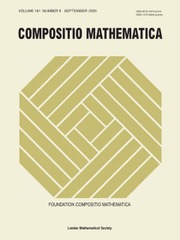Article contents
A new generic vanishing theorem on homogeneous varieties and the positivity conjecture for triple intersections of Schubert cells
Published online by Cambridge University Press: 10 March 2025
Abstract
In this paper we prove a new generic vanishing theorem for  $X$ a complete homogeneous variety with respect to an action of a connected algebraic group. Let
$X$ a complete homogeneous variety with respect to an action of a connected algebraic group. Let  $A, B_0\subset X$ be locally closed affine subvarieties, and assume that
$A, B_0\subset X$ be locally closed affine subvarieties, and assume that  $B_0$ is smooth and pure dimensional. Let
$B_0$ is smooth and pure dimensional. Let  ${\mathcal {P}}$ be a perverse sheaf on
${\mathcal {P}}$ be a perverse sheaf on  $A$ and let
$A$ and let  $B=g B_0$ be a generic translate of
$B=g B_0$ be a generic translate of  $B_0$. Then our theorem implies
$B_0$. Then our theorem implies  $(-1)^{\operatorname {codim} B}\chi (A\cap B, {\mathcal {P}}|_{A\cap B})\geq 0$. As an application, we prove in full generality a positivity conjecture about the signed Euler characteristic of generic triple intersections of Schubert cells. Such Euler characteristics are known to be the structure constants for the multiplication of the Segre–Schwartz–MacPherson classes of these Schubert cells.
$(-1)^{\operatorname {codim} B}\chi (A\cap B, {\mathcal {P}}|_{A\cap B})\geq 0$. As an application, we prove in full generality a positivity conjecture about the signed Euler characteristic of generic triple intersections of Schubert cells. Such Euler characteristics are known to be the structure constants for the multiplication of the Segre–Schwartz–MacPherson classes of these Schubert cells.
Keywords
MSC classification
Information
- Type
- Research Article
- Information
- Copyright
- © The Author(s), 2025. The publishing rights in this article are licensed to Foundation Compositio Mathematica under an exclusive licence
References
- 1
- Cited by


